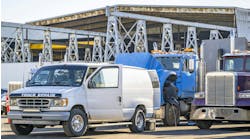Roeth: Technology and common-sense practices keep drivers cool in summer heat
Much of the country has already seen extremely high temperatures this summer, and people are scrambling to keep cool at home and on the job. This is undoubtedly true for truck drivers especially since for many, trucks serve as their home for at least a portion of the week.
Drivers have a right to be comfortable in their vehicles during rest periods, even when temperatures soar. Most cities have anti-idling laws that prevent drivers from idling their trucks for more than a few minutes, and even if they could idle, idling is bad for the environment.
Auxiliary power units, whether diesel- or battery-powered, are a key component of an idle-reduction strategy as they can provide cooling, heating, and electric power when the truck’s main engine is shut off. Of course, diesel APUs burn between 0.1 and 0.5 gallons of fuel per hour depending on their design, the ambient temperature, the sleeper’s insulation, and the resulting HVAC load, along with the AC power being generated. But this is far less fuel than would be burned by an idling main engine.
Many truck manufacturers are now offering battery APUs as factory options. Battery APUs' cooling capacity varies from 4,600 to 10,000 Btu/hour. Battery APU manufacturers say their units can provide 8 to 10 hours of cooling, but that number could be lower when temperatures are extremely high. Companies are now offering more substantial battery capabilities to extend the runtime to as much as a full 34 hours of rest.
There are other idle reduction options available, and I encourage you to review them to see which makes sense, given your duty cycles and use cases.
See also: Rohlwing: Are you ready for gator season?
Regardless of the idle-reduction solution you choose, you can do some simple and practical things to maximize the benefits of the selected solution. When spec’ing a truck, consider ordering extra cab/sleeper insulation. Several truck OEMs offer optional “Arctic Packages” that provide better insulation.
Drivers are a vital element in your idle reduction strategy. Remind them to pre-cool their trucks by running the vehicle’s air conditioning on high while driving just before shutting the truck engine off and turning on the APU. In addition, drivers should be encouraged to pull the curtain between the cab and sleeper and use window shades during rest periods.
When possible, drivers should park their trucks on concrete rather than asphalt, park in the shade whenever possible, and try to park the truck so the cab’s windshield is facing away from the sun. Remind drivers that limiting hotel loads will significantly extend the cooling hours of a battery APU.
Programmable engine parameters can also play a significant role in fleets' various idle-reduction strategies and technologies. These parameters not only control the exact speed at which an engine will idle but also set the idle timer length and establish boundaries for when idling is allowed for cold and hot temperature extremes. Make sure to review your programmable engine parameters periodically.
Even though we cannot control the weather, you can choose from several options to keep your drivers comfortable and cool during the summer heat.




